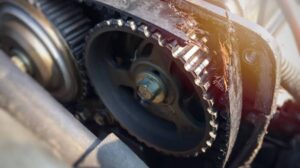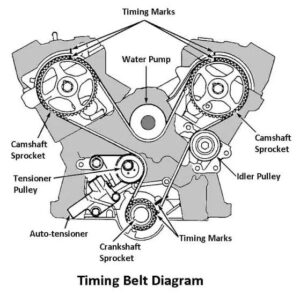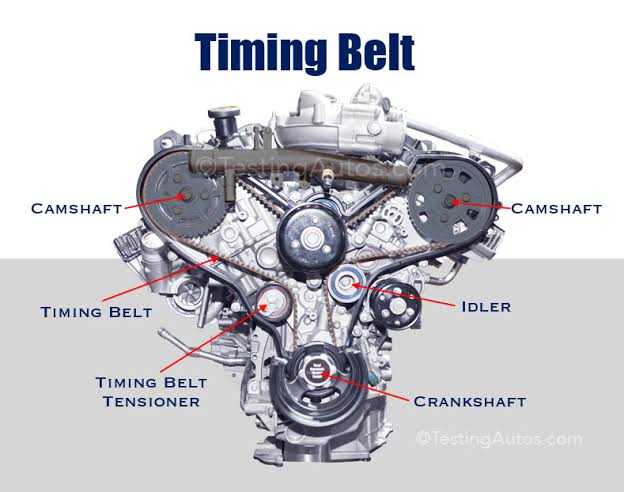Do you know what a timing belt is? It is a rubber belt that connects the camshaft and the crankshaft in your engine. The camshaft controls the opening and closing of the valves, while the crankshaft moves the pistons up and down. The timing belt makes sure that these two parts work together in harmony, creating the power that makes your car move.
The timing belt is one of the most important parts of your engine, but it is also one of the most overlooked. Many drivers don’t realize that the timing belt can wear out over time, causing serious problems for your engine. If you ignore the signs of a failing timing belt, you might end up with a broken engine that costs a lot of money to fix.
That’s why you need to pay attention to these 5 signs of a bad or failing timing belt. If you notice any of these symptoms, you should take your car to a mechanic as soon as possible to prevent further damage.
Signs of a Bad or Failing Timing Belt
Check Engine Light
Sometimes, a failing timing belt can turn on the check engine light on your dashboard. This light is a warning sign that tells you that something is wrong with your engine or its components. The check engine light can be caused by many different problems, but one of them could be a faulty timing belt. This means that the timing belt is affecting the rotation of the camshaft and the crankshaft, which are monitored by the camshaft position sensor and the crankshaft position sensor. These sensors send data to the engine’s computer, which controls the timing and fuel injection of the engine. If the timing belt is faulty, it may cause the sensors to send wrong data to the computer, causing it to detect an error. If you see the check engine light, you should scan your car with a diagnostic tool to find out the exact cause of the problem.

Engine Vibrations
One of the first signs of a failing timing belt is when your engine starts to vibrate. This means that your engine is not running smoothly or consistently. You might notice that your car makes noises when you start it or when you accelerate rapidly. This could also be a sign that there are other issues with your engine that need immediate attention. This happens because the timing belt is worn or damaged, and it can’t keep the camshaft and the crankshaft in sync. When this happens, the valves and the pistons can interfere with each other, causing damage to your engine.
Rough Idling
Another sign of a failing timing belt is when your car idles roughly when you stop at a traffic light or a stop sign. This means that your engine is not running at a steady speed or rhythm. You might notice that your car shakes, stutters, or stalls when you try to idle or accelerate. This happens because the timing belt is loose or stretched, and it can’t maintain the proper tension or alignment between the camshaft and the crankshaft. When this happens, the timing of the air and fuel intake and the combustion process is disrupted, affecting your engine’s performance.

Engine Misfiring
A failing timing belt can also cause your engine to misfire. This means that the spark plugs are not firing at the right time, causing your engine to run poorly or stop suddenly. You might notice that your car jerks, sputters, or backfires when you try to drive or accelerate. This happens because the timing belt is cracked or broken, and it can’t transmit the correct signals to the engine’s computer. When this happens, the timing of the valves and the pistons is out of sync, causing damage to your engine.
Poor Engine Performance
A failing timing belt can also affect your engine’s performance. You might notice that your car has less power, slower acceleration, or lower fuel efficiency. This means that your engine is not working as efficiently or effectively as it should. You might also notice more smoke or emissions coming out of your exhaust pipe than usual. This happens because the timing belt is slipping or has snapped, and it can’t deliver the right amount of air and fuel to the cylinders, affecting the combustion process. When this happens, your engine loses more power and performance over time.
Coolant Leaks
The last sign of a failing timing belt is when you see coolant leaks near the timing belt cover. The timing belt cover is a metal or plastic case that protects the timing belt from dirt and debris. Sometimes, the cover can crack or break, allowing coolant to leak out. This means that the timing belt is exposed to coolant, which can damage it or make it slip. Coolant leaks can also indicate that the timing belt tensioner or the water pump is failing, which can affect the timing belt as well.
Ticking Noise
A failing timing belt can also make a ticking noise from under the hood. This noise is caused by the teeth of the timing belt hitting against the gears or the pulleys that connect it to the camshaft and the crankshaft. This means that the timing belt is broken or loose, and it can’t grip the gears or the pulleys properly. If you don’t replace the timing belt soon, it might snap or slip off, causing your engine to stop working.

Importance of Timely Maintenance
As you can see, a failing timing belt can cause a lot of problems for your engine. That’s why you need to replace your timing belt regularly, according to your car’s manufacturer recommendations. Usually, this is every 60,000 to 100,000 miles, depending on your car model and driving conditions.
If you neglect this crucial maintenance, you might end up with a catastrophic engine failure, which can cost you thousands of dollars to repair or replace. Not to mention, a broken timing belt can leave you stranded on the road, putting you and others in danger.
Tips for Prevention
To prevent your timing belt from failing, you can follow these simple tips:
- Avoid driving in harsh conditions, such as extreme heat, cold, or dust, which can wear out your timing belt faster.
- Use high-quality replacement parts, such as OEM or aftermarket timing belts, tensioners, and water pumps, which can last longer and perform better.
- Consult a qualified mechanic for timely inspections and professional advice. A mechanic can check your timing belt for signs of wear and tear, and replace it if needed.
Conclusion
Your timing belt is a vital part of your engine, and you should not ignore the signs of a failing timing belt. If you notice any of the above symptoms, you should take your car to a mechanic as soon as possible to prevent further damage
By replacing your timing belt on time, you can avoid costly repairs, improve your engine’s performance, and extend your car’s lifespan. Don’t wait until it’s too late. Take action today and keep your timing belt in good shape.

